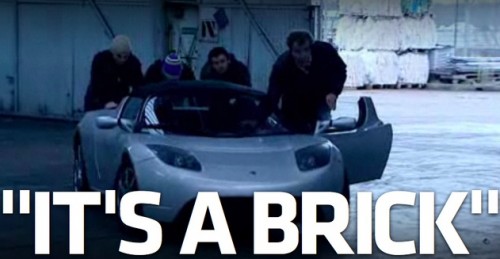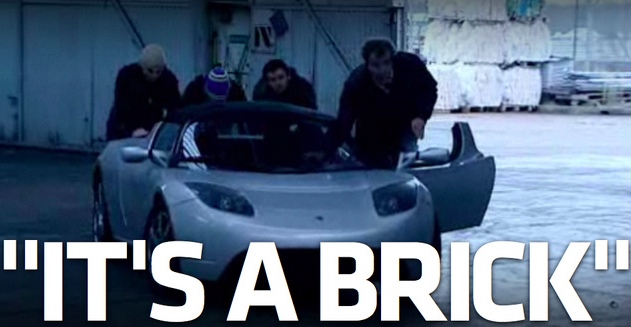
By David Ponce
So this story is a little shocking. It turns out that if you let your Tesla’s battery fully discharge, it becomes essentially destroyed. At that point, the car is one large brick. Nothing will work: you won’t even be able to turn the wheels so it can be towed conventionally. But it gets worse, much worse. If this happens, Tesla charges you $40,000 or so to get a new set of batteries. “Oh, but the waranty should cover it!” you’ll say. Nope, it specifically doesn’t. “Ok then, insurance will take care of it.” Wrong again. Insurance companies specifically do not cover this. Let the batteries go empty = $40,000 out of your account. “Ok, well, shoot… but maybe Tesla will let me finance that…” Wrong. Again. You pay in full, or you’ll be asked to get your expensive brick out of the dealership.
For something like this to happen isn’t that hard. Drive the car around so that it’s at, say, 50% charge and leave it at the airport for a week or so. Or park it in your own garage, but use an extension cord (as opposed to proper charging cables). Heck, you can think of a number of ways this could happen. And happen it did, to at least 5 devastated clients.
Tesla at the moment is in a bit of a predicament as it has to walk the fine line between aggressively warning its customers of the potential danger, and talking about it too much and risk spooking buyers off. And it’s even doing some potentially shady things (like remotely activating a GPS module in order to physically go plug a dying car in) to do what looks like some damage control. In official comments on the issue, representatives liken the problem to “making regular oil changes” and “maintaining a proper level of care”. Batteries, similarly, should never be allowed to fully discharge.
Well, we don’t know. Maybe this is a new class of problems that a new class of vehicles brings with it. Whatever the case, you should read the longer article at the link below. It’s pretty interesting.






This is utter nonsense. It is a well documented fact that these batteries get destroyed if you let them deplete completely. They have a protection circuitry that prevents that from happening when you drive, as it will shut down the battery before it gets completely depleted, but if you reach this point, and then leave your car off the charger for months, then you most certainly will destroy it.
And it is not a surprise either: it would happen to your laptop or smartphone battery as well, and it is a described failure mode.
The backlash against Tesla because of this would be akin to complaining that your car broke down after driving 50’000 miles without changing the oil: if you skip prescribed maintenence, you should expect your gizmo to get bricked at some point.
I get what you’re saying, and this is roughly what Tesla is saying. True. But here’s the problem. This is NOT a well known thing. I for one, didn’t know that this could happen if I let my iPhone or laptop completely discharge. Frankly, I’m a little skeptical. But even if you’re right, I still think it’s a fact that electric cars are a new category of vehicles and that owner education is very important. In an attempt to not scare potential buyers off, Tesla is being very timid about its warnings, and how serious this can be.
Remember, it’s one thing to drive 50,000 miles without changing the oil. After nearly 100 years of people owning combustion cars, it’s become common knowledge that you don’t do this. You do, however, leave your car off for long periods all the time. People have gotten used to doing this and not expect to come back to a brick. So there should be an even greater incentive to properly educate new owners of just how bad it can be. Transitioning to electric won’t be easy, but I’m not sure Tesla is going about it the right way.
Incidentally, there’s a lot of context I’m not mentioning in my article for lack of space. But do read Jalopnik’s and you might understand a little better why all the outrage.
um make the hood a solar panel and then issue disappears forever.
ive left a laptop unplugged for ten years, and it booted up fine. your logic is severely flawed.
Seriously? I’ve let my phone/laptop battery completely deplete (meaning years) and it’s still fired back up.
Also, the fact that all it takes is a week of not leaving it plugged in and your $40,000 in the hole is not even remotely similar to driving 50K without changing the oil. Look up the definition of the word “akin” — your comparison is laughable.
The onus is on Tesla to develop a vehicle that doesn’t require this type of babysitting — if they want to put it on the consumer then the customer will walk away and rightfully so.
Oh man! That is one expensive oops!